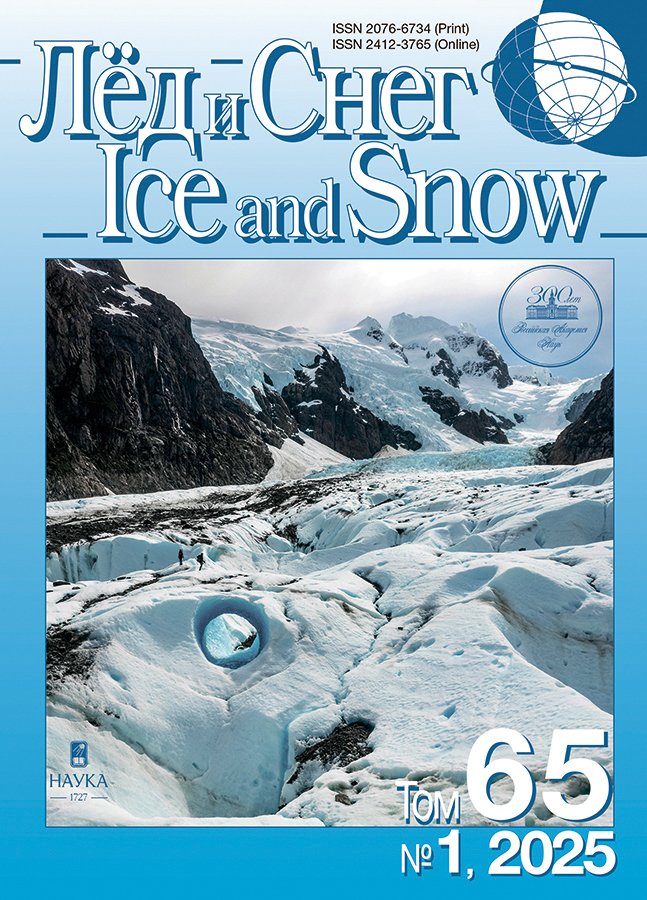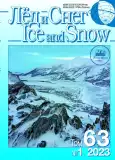Chemical Composition of the Hydro-Cryogenic System of Lake Baikal: “Snow on Ice–Ice–Water Under-Ice”
- Authors: Vorobyeva I.B.1, Vlasova N.V.1, Belozertseva I.A.1
-
Affiliations:
- V.B. Sochava Institute of Geography SB RAS
- Issue: Vol 63, No 1 (2023)
- Pages: 104-115
- Section: Sea, river and lake ices
- URL: https://journals.rcsi.science/2076-6734/article/view/137480
- DOI: https://doi.org/10.31857/S2076673423010155
- EDN: https://elibrary.ru/MAVNNX
- ID: 137480
Cite item
Full Text
Abstract
The results of studies of the chemical composition and the basic regularities of migration of macro- and microelements within the hydro-cryogenic system “snow on ice–ice–water under ice” obtained in the winter of 2016/17 in the waters of Lake Baikal are presented. Such investigation over the Lake area was carried out for the first time. It has been found that due to climatic conditions, dates of freeze-up (formation of the ice on the Lake) differ by 7–10 days from North to South, and the depth of snow on ice and its density change over the Lake area by 2 times, however there are some parts without snow. It was found that the changes in the pH indexes were identical across the whole Lake area – minimum pH values are present in the snow (from 5.59 to 7.39), average values – in the ice (6.01–7.50), and maximum values are noted in the water under ice (7.42–8.50). For the most part, increased quantities of suspended matter and an increase in the pH of snow were recorded near settlements, which is obviously a result of the anthropogenic influence. It was determined that the concentration of ions in the ice in relation to their content in the initial solutions decreases within the series: \({\text{NO}}_{2}^{ - }\) > Cl– > \({\text{SO}}_{4}^{{2 - }}\) > \({\text{HCO}}_{3}^{ - }\). Among the cations, K+, Na+ ions are involved into the ice intensively, while the Ca2+ and Mg2+ – weakly. The ice phase is enriched with ammonium ions outside the settlements. Near settlements and in shallow water, quantity of salts in the ice may be close to or equal to their concentration in the water under ice. The coefficient of migration in the water (Kx) divide the chemical elements into two groups – the mobile ones and slow-moving elements. The first group includes Ca, Cu, Sr, Mg, Co, Zn, and Cd (Kx >1), the second one contains Ba, Mn, Si, Fe, Al, Ti, Ni, Cr, P, and K.
About the authors
I. B. Vorobyeva
V.B. Sochava Institute of Geography SB RAS
Author for correspondence.
Email: irina-vorobyeva@yandex.ru
Russia, Irkutsk
N. V. Vlasova
V.B. Sochava Institute of Geography SB RAS
Email: irina-vorobyeva@yandex.ru
Russia, Irkutsk
I. A. Belozertseva
V.B. Sochava Institute of Geography SB RAS
Email: irina-vorobyeva@yandex.ru
Russia, Irkutsk
References
- Azhaev G.S. Evaluation of the ecological state of the city of Pavlodar according to the geochemical study of liquid and dust atmospheric precipitation. PhD. Pavlodar, 2007: 111 p. [In Russian].
- Alekin O.A., Semenov A.D., Skopinceva B.A. Rukovodstvo po himicheskomu analizu vod sushi. Guide to the chemical analysis of land waters. Leningrad: Hydrometeoizdat, 1973: 269 p. [In Russian].
- Anisimova N.P., Rogovskaya L.G. Changes in the chemical composition of lake ice over time // Ozyora kriolitozony Sibiri. Lakes of the permafrost zone of Siberia. Novosibirsk: Nauka, 1974: P. 128–137 [In Russian].
- Bajkal (Atlas) / Ed. G.I. Galazy. Moscow: Roskartography, 1993: 160 p. [In Russian].
- Berkin N.S., Makarov A.A., Rusinek O.T. Bajkalovedenie: ucheb. posobie. Baikal studies: textbook. Irkutsk: Irkutsk University Press, 2009: 291 p. [In Russian].
- Blinov V.V., Gnatovskij R.Yu., Zhdanov A.A., Granin N.G. Assessment of increase in mineralization in subglacial waters of South Baikal. Meteorologiya i gidrologiya. Meteorology and hydrology. 2019, 10: 60–66 [In Russian].
- Vlasov N.A., Pavlova L.I. Influence of freezing processes on the composition of hydrocarbonate withdrawals. Doklady Akademii Nauk SSSR. Reports of the Academy of Sciences. 1969, 185 (3): 675–678 [In Russian].
- Vojekov A.I. Vozdejstvie cheloveka na prirodu. Human impact on nature. Selected articles. Moscow: Gosudarstvennoye izdatel’stvo geographical literatury, 1949: 269 p. [In Russian].
- Vorob’eva I.B., Naprasnikova E.V., Vlasova N.V. Ecological-geochemical assessment system: snow on ice – ice – subglacial water lake. Baikal. Trudy Vseroscijskoj konferencii “Ledovye i termicheskie processy navodnyh ob’’ektah Rossii”. Proc. of the All-Russian Conference “Ice and thermal processes of flood facilities in Russia”. Arkhangelsk. Severnoye UGMS, August 28–31, 2007. Moscow: 2007: 87–90 [In Russian].
- Vorob’eva I.B., Naprasnikova E.V., Vlasova N.V. Ecological and geochemical features of snow, ice and subglacial water of the southern part of Lake Baikal. Geoekologiya. Inzhenernaya geologiya. Geokriologiya. Geoecology. Engineering geology. Geocryology. 2009, 1: 54–60 [In Russian].
- Vorob’eva I.B., Naprasnikova E.V., Vlasova N.V. Investigation of hydrocryogenic components of the South-West coast of Baikal (ecological-geochemical aspect). Led i Sneg. Ice and Snow. 2010, 2 (110): 56–60 [In Russian].
- Voropaj N.N., Vlasov V.K. Features of the distribution of snow cover on the coast of Lake Baikal Led i Sneg. Ice and Snow. 2017, 57 (3): 355–364 [In Russian]. https://doi.org/10.15356/2076-6734-2017-3-355-364
- Votincev K.K., Grigor’eva E.N. Characteristics of the chemical composition of the ice water of the Northern Kazakhstan lake. Doklady Akademii Nauk SSSR. Reports of the Academy of Sciences. 1973, 211 (6): 1405–1407 [In Russian].
- Glazovskij N.F., Zlobina A.I., Uchvatov V.P. Chemical composition of the snow cover of some regions of the Verkhneok basin. Regional’nyj ekologicheskij monitoring. Regional ecological monitoring. Moscow: Nauka, 1983: 67–86 [In Russian].
- GOST 17.1.5.05-85. General requirements for sampling of surface and sea water, ice and atmospheric precipitation. Moscow: 1985. Retrieved from: https://files.stroyinf.ru/Index2/1/4294847/4294847484.htm (Last access: 13.07.2022) [In Russian].
- GOST 2874-82. The water is potable. Hygienic requirements and quality control. Moscow: 1995. Retrieved from: http://gostvoda.ru/d/677526/d/4-gost-2874-82.pdf (Last access: 13.07.2022) [In Russian].
- Gosudarstvennyj doklad “O sostoyanii ozera Bajkal i merah po ego ohrane v 2016 godu”. State report “On the state of Lake Baikal and measures for its protection in 2016”. Irkutsk: INSHT, 2017: 374 p. [In Russian].
- Gosudarstvennyj doklad “O sostoyanii ozera Bajkal i merah po ego ohrane v 2017 godu”. State report “On the state of Lake Baikal and measures for its protection in 2017”. Irkutsk: ANO “KC Expert”, 2018: 340 p. [In Russian].
- Doklad ob osobennostyah klimata na territorii Rossijskoj Federacii za 2017 god. Report on the peculiarities of the climate in the territory of the Russian Federation for 2017. Moscow: 2018: 69 p. [In Russian].
- Doncheva A.V., Kazakov L.K., Kaluckov V.N. Landshaftnaya indikaciya zagryazneniya prirodnoj sredy. Landscape indication of pollution of the natural environment. Moscow: Ecology, 1992: 254 p. [In Russian].
- Zaharchenko A.V., Tigeev A.A., Pas’ko O.A., Kolesnichenko L.G., Moskovchenko D.V. Regional’nyj i lokal’nyj geohimicheskie perenosy veshchestv, deponirovannyj v snegovom pokrove. Regional and local geochemical transport of substances deposited in the snow cover. Moscow: Geoecology, 2020 (6): 41–53 [In Russian]. https://doi.org/10.31857/S0869780920060119
- Zvalinskij V.I., Mar’yash A.A., Tishchenko P.Ya., Sagalaev S.G., Tishchenko P.P., Shvecova M.G., Chichkin R.V., Mihajlik T.A., Koltunov A.M. Production characteristics of the estuary of the Razdolnaya River during the ice age. Vladivostok: Izvestiya TINRO, 2016 (185): 155–174 [In Russian].
- Ivanov A.V., Trofimova L.N., Vlasov N.A., Kashin N.P. Features of the distribution of phosphates in the ice of reservoirs. Geohimiya zony gipergeneza i tekhnicheskaya deyatel’nost’cheloveka. Geochemistry of the hypergenesis zone and human technical activity. Vladivostok. 1976: 73–86 [In Russian].
- Ivanov A.V. Formation of the chemical composition of congelation ice. Glyaciologicheskie i kriogennye gidrologi-cheskie processy. Glaciological and cryogenic hydrological processes. Vladivostok. 1989: 5–51 [In Russian].
- Ivanov A.V. Glyaciogennyj krugovorot veshchestv. Glaciogenic cycle of substances. Khabarovsk: IVEP DVO RAN, 1993: 94 p. [In Russian].
- Ivanov A.V. Kriogennaya metamorfizaciya himicheskogo sostava prirodnyh l’dov, zamerzayushchih i talyh vod. Cryogenic metamorphism of the chemical composition of natural ice, freezing and thawing waters. Khabarovsk: Dalnauka, 1998: 164 p. [In Russian].
- Karnauhova G.A. Changes in the hydrochemical composition of water during the operation of the Irkutsk reservoir. Moscow: Meteorologiya i gidrologiya. Meteorology and hydrology, 2018 (7): 87–96 [In Russian].
- Nemirovskaya I.A. Uglevodorody v okeane. Hydrocarbons in the ocean. Moscow: Scientific world, 2004: 318 p. [In Russian].
- Obzor sostoyaniya i zagryazneniya okruzhayushchej sredy v Rossijskoj federacii za 2015 god. Overview of the state and pollution of the environment in the Russian Federation for 2015. Moscow: Roshydromet, 2016: 200 p. [In Russian].
- Paradina L.F., Hahuraev O.A., Suturin A.N. Changes in the anthropogenic load on the snow cover of southern Baikal due to the closure of the Baikal pulp and paper mill. Mezhdunarodnyj nauchno-issledovatel’skij zhurnal. Intern. Research Journ. 2019, 79 (1): 90–94 [In Russian]. https://doi.org/10.23670/IRJ.2019.79.1.016
- Perel’man A.I., Kasimov N.S. Geohimiya landshafta. Geochemistry in the landscape. Moscow: Astraea-2000, 1999: 768 p. [In Russian].
- Prokacheva V.G., Usachev V.F. Snezhnyj pokrov v sfere vliyaniya goroda. Snow cover in the city’s sphere of influence. Leningrad: Hydrometeoizdat, 1989: 176 p. [In Russian].
- Sabylina A.V., Efremova T.A. Chemical composition of ice and subglacial water of Lake Onega (on the example of Petrozavodsk Bay). Led i Sneg. Ice and Snow. 2018, 58 (3): 417–428 [In Russian]. https://doi.org/10.15356/2076-6734-2018-3-417-428
- Sabylina A.V., Efremova T.A., Ikko O.I. Chemical composition of the hydrocryogenic system of lakes Munozero and Urozero (Republic of Karelia, Russia). Led i Sneg. Ice and Snow. 2020, 60 (4): 592–600 [In Russian]. https://doi.org/10.31857/S2076673420040063
- Saet Yu.E., Revich B.A., YAnin E.P., Smirnova R.S., Basharkevich I.L., Onishchenko T.L., Pavlova L.N., Trefilova N.Ya., Achkasov A.I., Sarkisyan S.Sh. Geohimiya okruzhayushchej sredy. Geochemistry of the environment. Moscow: Nedra, 1990: 335 p. [In Russian].
- Smahtin V.K. The Ice Regime of Lake Transbaikalia in the Conditions of Modern Warming. Led i Sneg. Ice and Snow. 2018, 58 (2): 225–230 [In Russian]. https://doi.org/10.15356/2076-6734-2018-2-225-230
- Sokol’nikov V.M. Nekotorye zakonomernosti formirovaniya i rosta ledyanogo pokrova na primere ozera Bajkal. Some regularities in the formation of ice cover on the example of Lake Baikal. “Work of the Baikal limnological station”. 1957, 15: 58–64 [In Russian].
- Sokol’nikov V.M. Vertical and horizontal displacements and deformations of the continuous ice cover of Baikal. Trudy Bajkal’skoj limnologicheskoj stancii. Proc. of the Baikal Limnological Station. 1960, 18: 291–350 [In Russian].
- Sokol’nikov V.M. Osobennosti otdachi Bajkalom tepla i vlagi pered ledostavom. Features of Baikal heat and moisture transfer before freezing. Novosibirsk, 1967: 121–123 [In Russian].
- Tarasov N.M., Korenovskaya I.M. Comparative characteristics of the chemical composition of ice and water in some water bodies of the North Caucasus. Gidrohimiya materialov. Hydrochemistry of materials. Leningrad: Hydrometeoizdat, 1966, 42: 196–210 [In Russian].
- Shimaraev M.N. Elementy teplovogo rezhima ozera Bajkal. An element of the thermal regime of Lake Baikal. Novosibirsk: Nauka, 1977: 150 p. [In Russian].
- Shostakovich V.B. Led na ozere Bajkal. Ice on Lake Baikal. Saint Petersburg: Main Hydrographic Department, 1908: 331–346 [In Russian].
- Obolkin V.A., Volkova E.A., Ohira S.I., Toda K., Netsvetaeva O.G., Chebunina N.S., Nosova V.V., Bondarenko N.A. The role of atmospheric precipitation in the under-ice blooming of endemic dinoflagellate Gymnodinium baicalense var. minor Antipova in Lake Baikal.
- Limnology and Freshwater Biology. 2019, (6): 345–352. https://doi.org/10.31951/2658-3518-2019-A-6-345
Supplementary files














